omeka
Item set
- Title
- omeka
- Description
- All items
Items
-
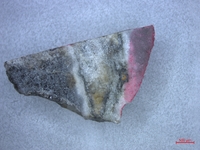 Vesicular glass material on one edge, along with one of the xenoliths in xenoliths is present, with orange core, reaction rim to the white material. There are some dark red minerals in the white and orange portion of this chip.
Vesicular glass material on one edge, along with one of the xenoliths in xenoliths is present, with orange core, reaction rim to the white material. There are some dark red minerals in the white and orange portion of this chip. -
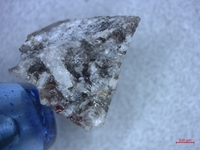 Darker glass material along with the white streak material are present in this rock chip
Darker glass material along with the white streak material are present in this rock chip -
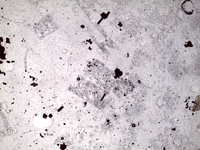 Mostly a glassy material with some light vesiculation. There are many phenocrysts of zoned and twinned minerals, many of which have embayments or sieve texture. There are some opaque minerals in clusters throughout the sample, some of which are inclusions within the larger phenocrysts. There are some clusters of the same material of phenocrysts in much smaller, but more plentiful amounts
Mostly a glassy material with some light vesiculation. There are many phenocrysts of zoned and twinned minerals, many of which have embayments or sieve texture. There are some opaque minerals in clusters throughout the sample, some of which are inclusions within the larger phenocrysts. There are some clusters of the same material of phenocrysts in much smaller, but more plentiful amounts -
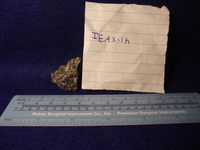 There are two main components of this sample. A dull white material and a glassy black material. The white material comes in large somewhat elongate blobs, while the glass is surrounding it with very few vesicles spread throughout
There are two main components of this sample. A dull white material and a glassy black material. The white material comes in large somewhat elongate blobs, while the glass is surrounding it with very few vesicles spread throughout -
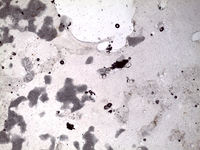 The dark gray glass material is almost all glass with some vesiculation. The white streaks in hand sample are formed from microlites consisting of low birefringent minerals. These sections appear to be at disequilibrium with the rest of the sample with embayments and a coarsening inwards of the clusters. There is almost a clean transition from the white glass to the dark brown glass, which represents the heavily vesiculated portion of the sample. The vesicles in this portion are much larger, and much more prominent. A similar material from the white glass section, where there are low birefringent microlites, but these are elongate minerals that appear to be growing into the glass material.
The dark gray glass material is almost all glass with some vesiculation. The white streaks in hand sample are formed from microlites consisting of low birefringent minerals. These sections appear to be at disequilibrium with the rest of the sample with embayments and a coarsening inwards of the clusters. There is almost a clean transition from the white glass to the dark brown glass, which represents the heavily vesiculated portion of the sample. The vesicles in this portion are much larger, and much more prominent. A similar material from the white glass section, where there are low birefringent microlites, but these are elongate minerals that appear to be growing into the glass material. -
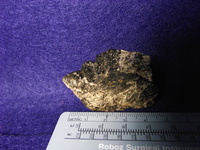 Overall, this sample is a dark gray aphanitic rock with few vesicles throughout, but a heavy concentration in one portion of the sample. There are streaks of white material interwoven with the dark gray material. The heavily vesiculated section of the rock is a black glass material, with a pumiceous texture. The dark gray material lightens away as it gets farther from the black glass section. There are a few small black streaks running through the dark gray. There is some of the gray material covering white streaks, where it shows some translucence. There are two shapes of the white material, either streaks within the hand sample, or webbed like portions. There is no concentrated portion of this white material.
Overall, this sample is a dark gray aphanitic rock with few vesicles throughout, but a heavy concentration in one portion of the sample. There are streaks of white material interwoven with the dark gray material. The heavily vesiculated section of the rock is a black glass material, with a pumiceous texture. The dark gray material lightens away as it gets farther from the black glass section. There are a few small black streaks running through the dark gray. There is some of the gray material covering white streaks, where it shows some translucence. There are two shapes of the white material, either streaks within the hand sample, or webbed like portions. There is no concentrated portion of this white material. -
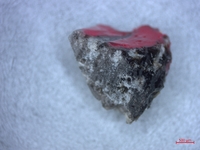 There is a very small amount of the darkest glass near the edge, along with a lot of the lighter gray glass and white microlite cluster material.
There is a very small amount of the darkest glass near the edge, along with a lot of the lighter gray glass and white microlite cluster material. -
 Mostly the white groundmass material but has some dark red mineral inclusions, along with one metallic looking inclusion
Mostly the white groundmass material but has some dark red mineral inclusions, along with one metallic looking inclusion -
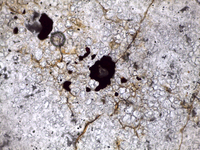 The groundmass is made of small, equant, very low birefringent minerals mixed together with glass. There are also many opaque minerals mixed throughout of many different sizes. There are some extremely dark red minerals mixed in within the opaque minerals. Some of these opaque minerals have inclusions within them. There are some isotropic minerals with opaque mineral inclusions.
The groundmass is made of small, equant, very low birefringent minerals mixed together with glass. There are also many opaque minerals mixed throughout of many different sizes. There are some extremely dark red minerals mixed in within the opaque minerals. Some of these opaque minerals have inclusions within them. There are some isotropic minerals with opaque mineral inclusions. -
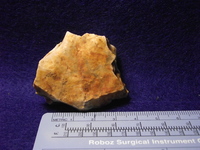 Mostly a white sample with some yellow or light gray patches of material, with dark specks. The majority of the sample is the milky white material. The yellow coloring is most prominent near the cracks, and could be reactions with the air, since it also rims around the dark specks. The light gray patches are slightly translucent and are formed in clumps. They can be intertwined, surrounding, or surrounded by the white material. The broken part of the light gray material appears to possibly show conchoidal fracturing. The dark specks are very small, 50 micron dark red round minerals which are spread evenly throughout the sample.
Mostly a white sample with some yellow or light gray patches of material, with dark specks. The majority of the sample is the milky white material. The yellow coloring is most prominent near the cracks, and could be reactions with the air, since it also rims around the dark specks. The light gray patches are slightly translucent and are formed in clumps. They can be intertwined, surrounding, or surrounded by the white material. The broken part of the light gray material appears to possibly show conchoidal fracturing. The dark specks are very small, 50 micron dark red round minerals which are spread evenly throughout the sample. -
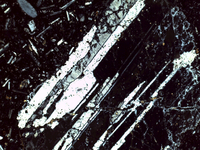 Mostly light brown to white groundmass with a glassy texture and elongate white microlites scattered throughout. Some vesicles and opaque minerals are seen. There are many large twinned phenocrysts, many of which have inclusions of opaque minerals. Some of these have some evidence for disequilibrium, including embayments and some sieve texture.
Mostly light brown to white groundmass with a glassy texture and elongate white microlites scattered throughout. Some vesicles and opaque minerals are seen. There are many large twinned phenocrysts, many of which have inclusions of opaque minerals. Some of these have some evidence for disequilibrium, including embayments and some sieve texture. -
 This sample is mostly dark gray to black ground mass, with most faces being smooth, and one face being covered in vesicles. There are small pockets of vesicles elsewhere in the sample as well. There are dark gray inclusions which are mostly spherical with uniform dark gray color, some cleavage faces, with a fairly smooth transition into the groundmass. Some of the inclusions extrude from the rest of the groundmass however. Most inclusions are 1-2.5 cm in diameter, with the largest being 3 cm. There are some small phenocrysts found, with the largest seen being 5 mm in length. These are intergrown with the groundmass. There are some vesiculated portions of the ground mass, and the vesicles showing a lot of glassy texture. There is one strange inclusion where it looks like a dark gray inclusion in disequilibrium with the groundmass, where vesicles are present around the inclusion. The other inclusions do not have vesicles surrounding them.
This sample is mostly dark gray to black ground mass, with most faces being smooth, and one face being covered in vesicles. There are small pockets of vesicles elsewhere in the sample as well. There are dark gray inclusions which are mostly spherical with uniform dark gray color, some cleavage faces, with a fairly smooth transition into the groundmass. Some of the inclusions extrude from the rest of the groundmass however. Most inclusions are 1-2.5 cm in diameter, with the largest being 3 cm. There are some small phenocrysts found, with the largest seen being 5 mm in length. These are intergrown with the groundmass. There are some vesiculated portions of the ground mass, and the vesicles showing a lot of glassy texture. There is one strange inclusion where it looks like a dark gray inclusion in disequilibrium with the groundmass, where vesicles are present around the inclusion. The other inclusions do not have vesicles surrounding them. -
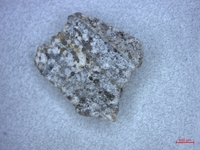 Dark gray glass material along with white microlite patches are present on this rock chip
Dark gray glass material along with white microlite patches are present on this rock chip -
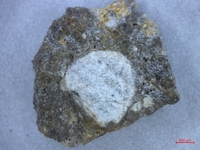 Larger rounded light gray feature, with orange material and vesicular glass are present in this rock chip.
Larger rounded light gray feature, with orange material and vesicular glass are present in this rock chip. -
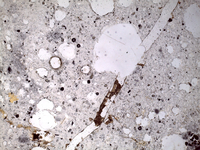 There is a glassy matrix with vesicles ranging in sizes from small to extremely large. There are also many microlites of small, low birefringent minerals showing simple twinning, and some lamellar twinning. There are also larger phenocrysts of the minerals seen throughout the glassy matrix, many of which appear to be heavily fractured or in disequilibrium. There are also a couple medium to high birefringent minerals found throughout the sample, most likely some type of pyroxenes. There are some fractures through the rocks which connect vesicles, but are filled by the glassy matrix. Some portions of this sample are more vesiculated than others. These less vesicular sections contain a lot of fine twinned microlites with a dark red rounded microlite mixed in. There are some large clasts which have been fractured and filled in by the surrounding groundmass. This clast also shows disequilibrium with the surrounding groundmass. One is concentrated with low birefringent twinned minerals, with some higher birefringent phenocrysts.
There is a glassy matrix with vesicles ranging in sizes from small to extremely large. There are also many microlites of small, low birefringent minerals showing simple twinning, and some lamellar twinning. There are also larger phenocrysts of the minerals seen throughout the glassy matrix, many of which appear to be heavily fractured or in disequilibrium. There are also a couple medium to high birefringent minerals found throughout the sample, most likely some type of pyroxenes. There are some fractures through the rocks which connect vesicles, but are filled by the glassy matrix. Some portions of this sample are more vesiculated than others. These less vesicular sections contain a lot of fine twinned microlites with a dark red rounded microlite mixed in. There are some large clasts which have been fractured and filled in by the surrounding groundmass. This clast also shows disequilibrium with the surrounding groundmass. One is concentrated with low birefringent twinned minerals, with some higher birefringent phenocrysts. -
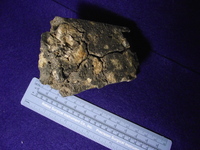 Overall there is a dark gray groundmass with multiple larger inclusions, varying in color, along with smaller lighter color specks of inclusions and heavily fractured. The groundmass is very dark gray to black with heavy vesiculation on one portion of the sample, even coloration throughout the sample, and fractures filled with sediment. The large white to light gray inclusion is up to three centimeters in diameter, heavily fractured and possibly cleaved, some yellow discoloration. The orange clasts look similar to the yellow discoloration found in the large inclusion, but more concentrated in color. There are small pockets of melt coming through these smaller inclusions, implying some disequilibrium with the inclusion and the melt. There are also some subhedral phenocrysts of minerals, most likely feldspars and smaller pieces of the larger white clast.
Overall there is a dark gray groundmass with multiple larger inclusions, varying in color, along with smaller lighter color specks of inclusions and heavily fractured. The groundmass is very dark gray to black with heavy vesiculation on one portion of the sample, even coloration throughout the sample, and fractures filled with sediment. The large white to light gray inclusion is up to three centimeters in diameter, heavily fractured and possibly cleaved, some yellow discoloration. The orange clasts look similar to the yellow discoloration found in the large inclusion, but more concentrated in color. There are small pockets of melt coming through these smaller inclusions, implying some disequilibrium with the inclusion and the melt. There are also some subhedral phenocrysts of minerals, most likely feldspars and smaller pieces of the larger white clast. -

-

-

-

-

-

-

-
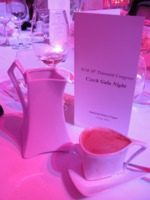
-

